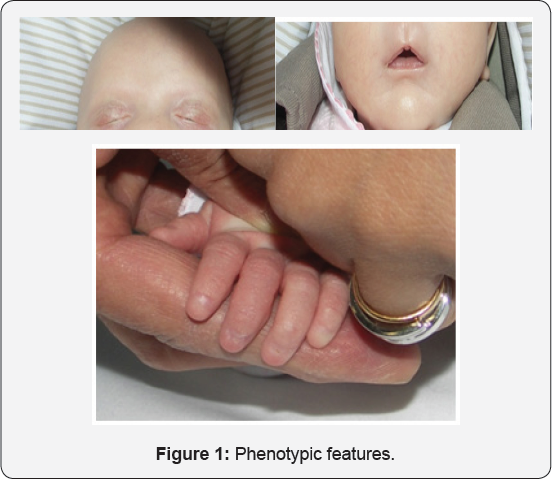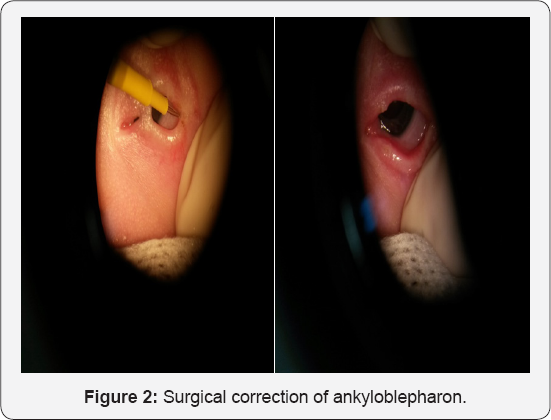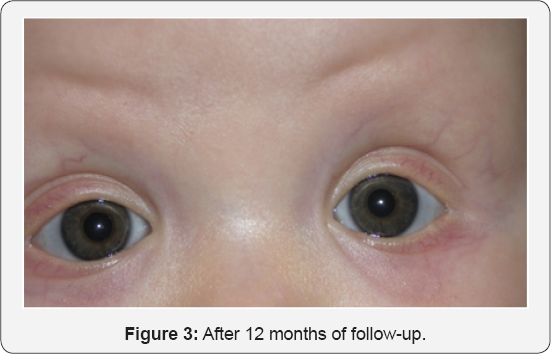Juniper
Publishers- JOJ Ophthalmology
Abstract
Introduction: Hay-Wells Syndromeis a rare
disease with an autosomal dominant transmission. It is a type of
ectodermal dysplasia, leading to impaired development of hair, nails,
teeth and glands, usually in association with cleft palate and/or lip
and ankyloblepharon. This syndrome is present at birth and diagnosis is
made based on child phenotypic features. This study aims to describe a
case of this syndrome.
Case report: Authors describe a case of a
newborn with no history of parental consanguinity or other similar cases
in the family. At birth alopecia, ankyloblepharon, cleftpalate,
micrognatia and absent nails were detected. Surgical correction of
ankyloblepharon was done. Postoperative period had no complications and
after 12 months of follow-up lid edges are completely free.
Discussion: As a genetic disease, treatment is
symptom-oriented. Antibiotic ointments can be used in skin lesions.
Surgery is reserved for correction of cleft palate/lip and
ankyloblepharon. Genetic counseling is recommended.
Keywords: Syndrome; Ectodermal dysplasia; Ankyloblepharon cleft palate and lipIntroduction
Hay-Wells Syndrome, also known as AEC syndrome
(ankyloblepharon-ectodermal dysplasia- clefting syndrome), is a rare
genetic disease [1],
with an autosomal dominant transmission. Sporadic cases have, however,
also been described. First described by Hay and Wells in 1976 [2],
it was later found that it is caused by a p63 gene mutation, a known
regulator of epithelial development/differentiation and homologous of
the TP53 oncosupressor gene [3,4].
It is a type of ectodermal dysplasia, leading to impaired development
of hair, nails, teeth and glands, usually in association with cleft
palate and/or lip and ankyloblepharon. These are considered the cardinal
signs of the syndrome by most authors. This syndrome is present at
birth and diagnosis is made based on the child's phenotypic features.
The authors aim to describe a case of a male newborn with the cardinal
signs of this syndrome at birth, as it is a very rare syndrome with just
a few cases reported worldwide.
Case Report
Male white newborn with no history ofparental
consanguinity or other similar cases in the family. The baby was born by
spontaneous vaginal delivery after an uneventful pregnancy with good
prenatal care. At birth alopecia, ankyloblepharon, cleft palate,
micrognathia and absent nails were detected (Figure 1a,1b & 1c-
Phenotypic features). Anterior segment was normal, with no detected
anomalies in the lacrimal apparatus. The rest of the physical
examination was normal.

Ophthalmic ultrasound revealed a normal posterior
segment. Abdominal and pelvic ultrasound were normal. Head ultrasound
showed a small cyst in the pellucid septum and an apparent thickening in
optic chiasmal area. Further study with Cranial MRI was normal, thus
excluding a septum-optic dysplasia. Blood tests (CBS, electrolytes,
hepatic function, kidney function, imunophenotyping and immunoglobulin
levels) revealed a decrease in immunoglobulin A (X; normal range X),
with no other changes. Hearing tests were normal.
Dermatology consultation recommended topical
streoids in scarceeczematous areas and daily mineral ointments. Later
hair prosthesis was discussed with the parents. Surgical correction of
ankyloblepharon was carried out by ophthalmologists. Tearing of lid
bridges was done in the operating room, under general anesthesia, using
an electric scalpel in both eyes (Figure 2-
Surgical correction of ankyloblepharon). Careful tearing with gentle
pulling of the eyelids was carried out in order not to damage the
underlying cornea. Post-operative period had no complications and after
12 months of follow-up lid edges are completely free (Figure 3 - After 12 months of follow-up).


Cleft palate was complete, type III. Surgical
correction was performed according to Furlow and Von Langenbeck
procedures by pediatric surgeons. Blood molecular analysis of TP63
mutations and deletions/duplications was normal; we are still waiting
for molecular analysis of mouth mucosa specimen. Unfortunately, it was
not possible to have parental authorization to carry DNA analysis in
their cells. Speech therapy was also prescribed.
Discussion
Hay-Wells Syndrome, also known as AEC Syndrome
(ankyloblepharon-ectodermal dysplasia-clefting), is a rare autosomal
dominant disease [1]. Ankyloblepharon, ectodermal dysplasia signs and cleft palate are considered cardinal signs of this syndrome [5]. All of these features were present in our case.
Ankyloblepharon results from fusion, partial or
total, of superior and inferior lid edges. In general, eyelids remain
closed until the 5th week of gestation, when they open
spontaneously. The mechanism underlying this phenomenon is still on
debate, but many author point out keratinization as the key [6]. Accordingly, any kind of anomaly occurring between 7th and 15th week of gestation can result in eyelid anatomy changes [6].
Ankyblepharon can also be present in Trisomy 18 and CHAND Syndrome
(Curly hair-Ankyblepharon-Nail Dystrophy), being associated with heart
malformations, hydrocephaly, imperforated anus and glaucoma.
Ankyblepharon should then be a warning sign for the possibility of other
important simultaneous diseases [7].
Ectodermal dysplasias are a group of diseases in
which there is impaired development of hair, teeth, nails, sweet glands
and other structures originating from ectoderm [8,9].
These anomalies, when associated with other malformations, correspond
to a group of ectodermal dysplasia syndromes that includes EEC Syndrome
(ectodactilia-ectodermal dysplasia- clefting), Rapp-Hodgkin Syndrome and
Chand Syndrome, the most important differential diagnosis of Hay-Wells
Syndrome [9]. In our case, none of the other malformations were identified, so that Hay-Wells Syndrome diagnosis was straight forward.
Hay-Wells Syndrome patients can have various degrees
of alopecia, thin and scarce hair, onicodystrophies, palmoplantar
hyperkeratosis, cutaneous pigment changes [10],
hypohidrosis, hypodontia, teeth malformations and ear anomalies.
Lacrimal canal obstruction is common. Other described features include
super numerary nipples, otitis media, hypospadia, middle-facial
hypoplasia, hypertelorism, low height, mental retardation, deafness and
other ocular deformities.
At birth, a descamative erythrodemia can be seen,
with superficial erosion and crusts. Scalp area usually shows an erosive
dermatitis, which is a common source of infection, putting these
patients at an increased risk of bacterial superinfection and sepsis;
this leads to an increase in mortality and morbidity rate in newborns
with this syndrome. A lot of Hay-Wells Syndrome cases are erroneously
diagnosed as bullous epidermolysis due to the presence of erythrodermia
and extensive areas of erosion. It is thought that scalp lesions can
disappear with age or lead to alopecia [3].
Although concerns exist about wound healing in
patients with this syndrome, there have been no reported instances of
wound healing complications. Cleft lip and palate repair can then be
performed safely in patients with Hay-Wells syndrome.
This syndrome is caused by a p63 gene mutation, an homologous of p53 oncosupressor gene [3,4],
which has a central role in epidermal stratification process,
regulating basal keratocyts proliferative capacity. Evidence showing
that changes in this gene can be associated with other diseases like EEC
and Rapp-Hodgkins syndrome reveal the high pleomorphic effect of p63
gene mutations. Hay-Wells Syndrome results specifically from amino-acid
substitution in SAM domain (sterile alpha motif) [3,4].
Timely diagnosis is essential. As a genetic disease
with multiple phenotypic features, multidisciplinary action is of main
importance and treatment is symptom-oriented. Antibiotic ointments can
be used in skin lesions. Surgical treatment is reserved for correction
of cleft palate/lip and ankyloblepharon. Genetic counseling is
recommended.
Disclosure statement
No sponsorship or funding arrangements relating to research and no conflicts of interest to declare.
For more articles in JOJ Ophthalmology (JOJO) please click on: https://juniperpublishers.com/jojo/index.php
No comments:
Post a Comment